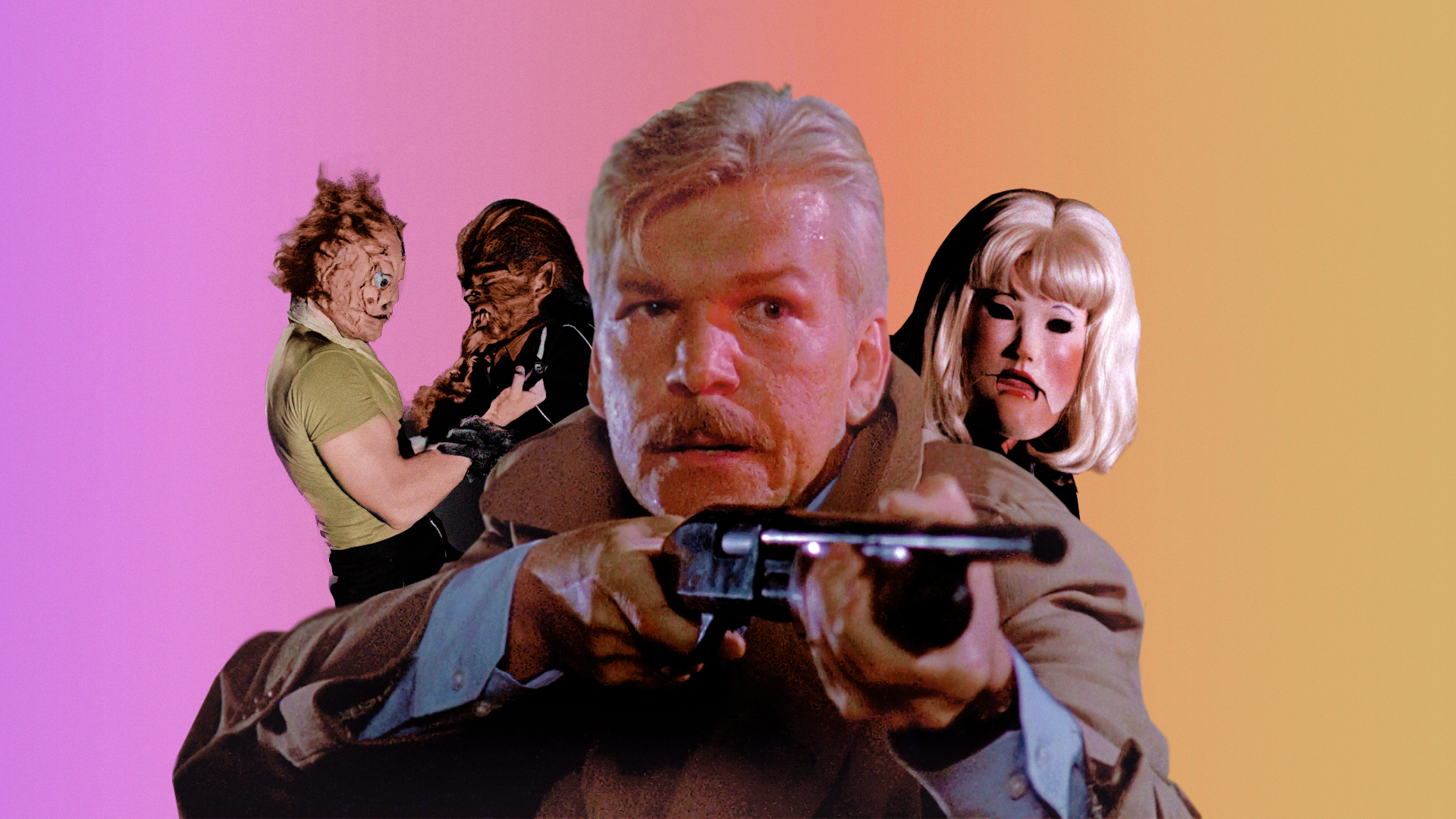It’s that time of year again, folks. October is upon us, and that means spooks, ghouls, and ghosts.
As we approach Halloween 2021, allow me to offer some suggestions for haunting horrors to grace your screens. Bypassing the usual classics like The Exorcist (1973) or Halloween (1978), I hope this eclectic mix can add something new to your own October line-up.
As the Goosebumps television opening would say, “you will beware, you’re in for a scare!”
How to Make a Monster (1958)
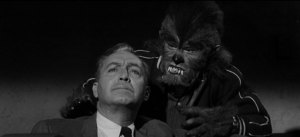
In 1957, American International Pictures (AIP) had seen great success with I Was a Teenage Werewolf and I Was a Teenage Frankenstein. Forming the third part of this loose trilogy was 1958’s How to Make a Monster.
The film sees American International Pictures become “American International Studios”, taking on a fictionalised visage. The studio is finishing up its latest horror hit, pitting the Teenage Werewolf and Teenage Frankenstein against one another. It is truly a shame that this never actually came to fruition. Providing makeup for these films is Pete Dumond (Robert Harris), who is told that horror pictures are old hat, and that the studio no longer needs him. Naturally, this prompts Dumond to kill those who’ve wronged him, using his own monstrous makeup to hypnotise the young actors playing the teenage Werewolf and Frankenstein (Gary Clarke and Gary Conway, respectively) into doing his bidding.
This is a delightfully self-aware horror picture. AIP cleverly allow themselves to recycle the Teenage Werewolf and Frankenstein makeup effects, and given how striking they are in their own films, it’s great to see them again one more time.
In a way, the film almost mirrors the life of AIP’s chief monster-maker, Paul Blaisdell. Blaisdell had created a multitude of unforgettable creatures for the company’s ‘50s horror fare, greatly elevating the likes of The She-Creature (1956), It Conquered the World (1956), and Invasion of the Saucer Men (1957) among others. However, as the decade wore on, Blaisdell’s talents were largely cast aside, and his work with AIP didn’t survive into the ‘60s.
In fact, many of Blaisdell’s creatures can be seen in the film’s climax, repurposed as the work of Dumond.
The Skull (1965)
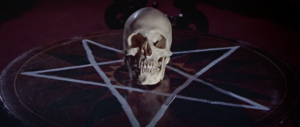
No October horror line-up is complete without Peter Cushing or Christopher Lee. Thankfully, Amicus Productions featured both masters in 1965’s The Skull.
The film begins with Cushing and Lee in a bidding war over a skull allegedly belonging to the Marquis de Sade. As the skull changes hands over the course of the film, one thing is certain: it can make its owner commit murder, and it’s alive!
While the film drags in a few spots, this is an appropriately spooky film for the season. The climax features no dialogue whatsoever, and has the skull come to life. If you’re worried that you’re in for the same antics as The Screaming Skull (1958) – which, for the record, is not as bad as some would have you believe – fear not, for The Skull’s great use of shadows and darkness makes its final reel rather effective and creepy. The film’s lush colour photography also makes it a treat for the eye.
As is expected, Lee and Cushing are wonderful. Any film that features them together is a gem.
Tourist Trap (1979)
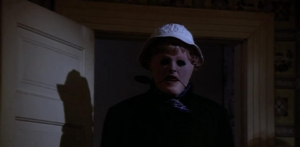
If the Autons from Doctor Who didn’t make you scared of mannequins, this film will.
Tourist Trap sees four young people stranded when their car mysteriously breaks down. Coming to their aid is Slausen (Chuck Connors), a kindly old gentleman who runs a now-defunct tourist trap, a wax museum. Not far from the museum is an old house, and while Slausen goes out to help with the car, one of the party ventures inside. That’s when they’re suddenly attacked by a hulking menace whose face is hidden behind a horrifying wax imitation. From then on, the nightmare explodes.
Above all else, Tourist Trap is worth seeing because it is unbelievably creepy. If an air of The Texas Chain Saw Massacre (1974) hangs over the picture, it’s no surprise. Robert Burns served as art director on both films, and what he achieved with bones and dead animals in Chain Saw, he matches with plastic faces and mannequin parts in Tourist Trap.
In some ways, it’s hard to describe Tourist Trap without spoiling things because its various twists and turns pull from several horror subgenres. Its contemporary slasher elements are tempered by the supernatural, and there’s a firm lineage to Alfred Hitchcock’s Psycho (1960).
While some of the characters are thinly-drawn, Chuck Connors gives a noteworthy performance as Slausen, and the aforementioned art direction is striking enough on its own to warrant recommendation.
Night of the Creeps (1986)
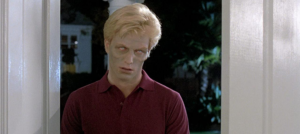
When it comes to this kind of list, the 1980s seems like the most obvious decade to mine. Indeed, the number of iconic titles produced is astonishing, from Friday the 13th (1980) and A Nightmare on Elm Street (1984) to less well-known offerings like C.H.U.D. (1984) or the stylish slasher that is Aquarius (1987).
Nevertheless, I felt compelled to include something from the ’80s, so I’ve selected one of my favourites: Night of the Creeps.
In 1959, an infected alien jettisons a tube containing parasitic worms into the depths of space. Falling to Earth like the meteorite at the start of The Blob (1958), the worms escape and jump into the mouth of a teenager. Cut to 1986, and Chris Romero (Jason Lively) and JC Hooper (Steve Marshall) are trying to steal a body from their college’s cryogenics lab in order to join a fraternity. It just so happens that the body they find is that of the teenager from 1959. He’s not quite dead, and neither are the parasitic brain worms in his head…
This movie is wonderful on multiple levels. Chris and CJ are very likeable leads; the many visual and narrative references to ‘50s science fiction are delightful; the special makeup effects are deliciously grotesque; and Tom Atkins (playing a detective) gives us a handful of memorable lines.
If you happen to have the Eureka Entertainment blu-ray (featuring the director’s cut ending), scholar Craig Ian Mann offers a brilliant analysis in his accompanying essay. Without spoiling his observations, the way in which the film appropriates ‘50s sci-fi aesthetics (both overtly and implicitly) mirrors the cultural climate of Ronald Reagan’s ‘80s America. The return of a monster menace from the ’50s reflects Reagan’s resurrection of that decade’s conservatism.
Occult (2009)
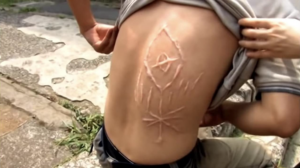
Kōji Shiraishi’s found-footage horror films are among the most unsettling. Thanks to platforms like Shudder, new audiences have been introduced to his films, with Noroi: The Curse (2005) giving this author recurring nightmares for three days – it’s that good!
Shiraishi’s 2009 horror, Occult, is also worth checking out. Though perhaps not as immediately frightening as Noroi, Occult certainly stays with you.
The film opens with footage of a terrorist attack. One of the only survivors is Shohei Eno, who had an unknown pattern carved into his body by the attacker. Eno becomes increasingly convinced that he must also carry out a terror attack, all while claiming to see strange, leech-like creatures floating in the sky. Only when the film’s director (Shiraishi playing himself) sees these creatures as well does the film enter increasingly dangerous territory.
As with Noroi, this is a masterfully unnerving film. We spend a lot of time hearing Eno describing horrors rather that actually seeing them – as in Noroi – which is why it feels less immediately frightening, but it certainly feels more real.
The visibility of terrorism over the last twenty years – as an idea, as a collection of real events, and as a factor which informs political policy – has meant that we’re more familiar with it than ever. Therefore, the intimacy that Occult presents in putting us this close to someone gearing up for the unthinkable is greatly distressing. In fact, the film’s various spooky moments – while very effective – don’t linger quite as uncomfortably as extended dialogue scenes with Eno.
This is a remarkably effective horror film, and certainly one to watch during the Halloween season. Though, if you’ve recently seen Noroi, perhaps give yourself a break before director Shiraishi terrifies you for a second (or third) time!
We hope you’ve enjoyed reading these recommendations for the Halloween season. In the words of the immortal Elvira, Mistress of the Dark, “unpleasant dreams!”
A special thanks to Josh Naugh for providing this article’s fabulous header image. Please visit the Biorante website to see more of his edits.
